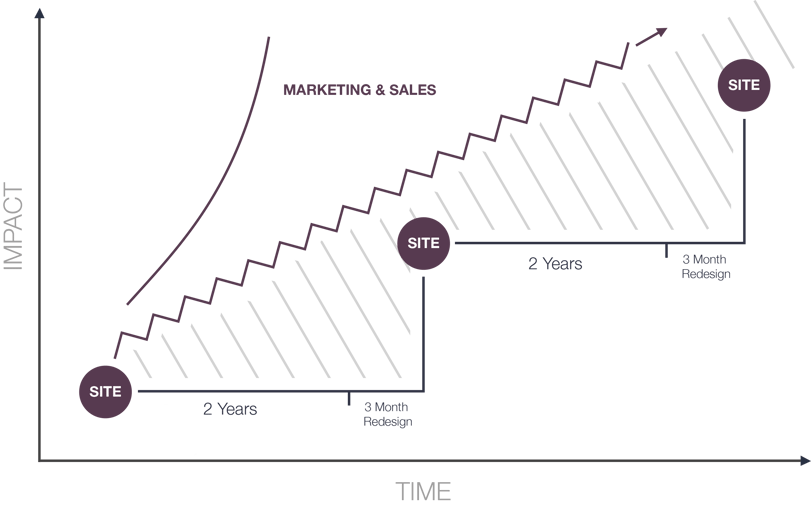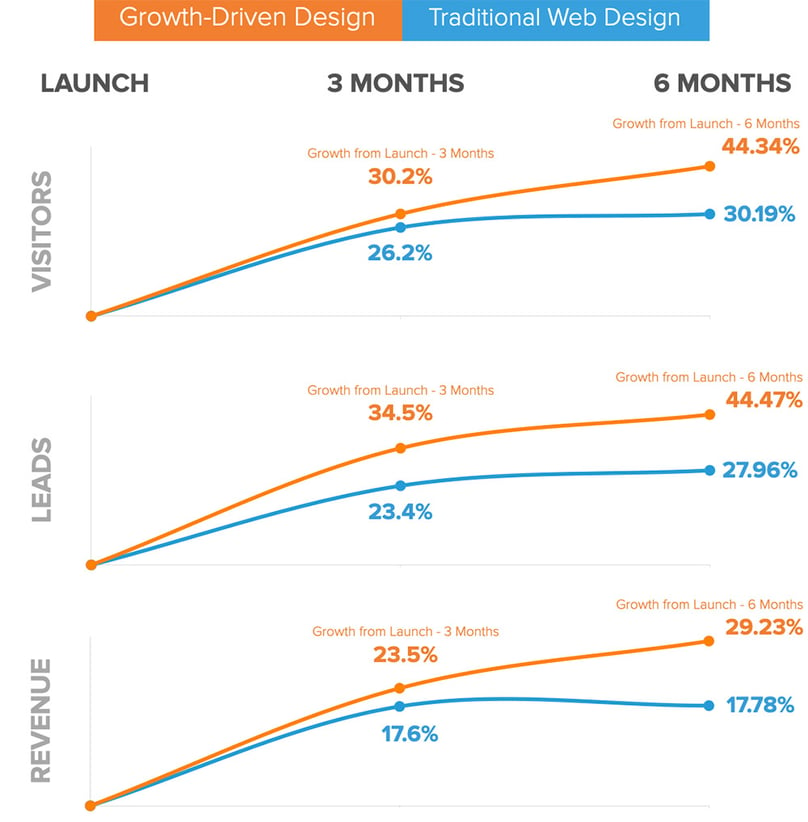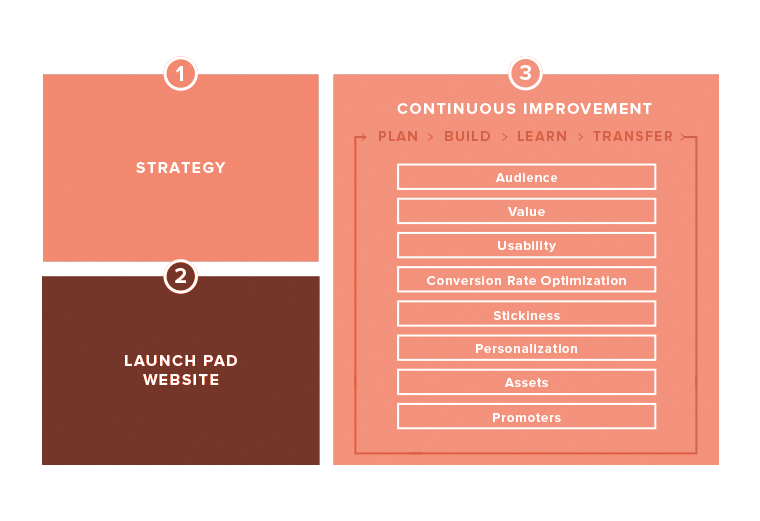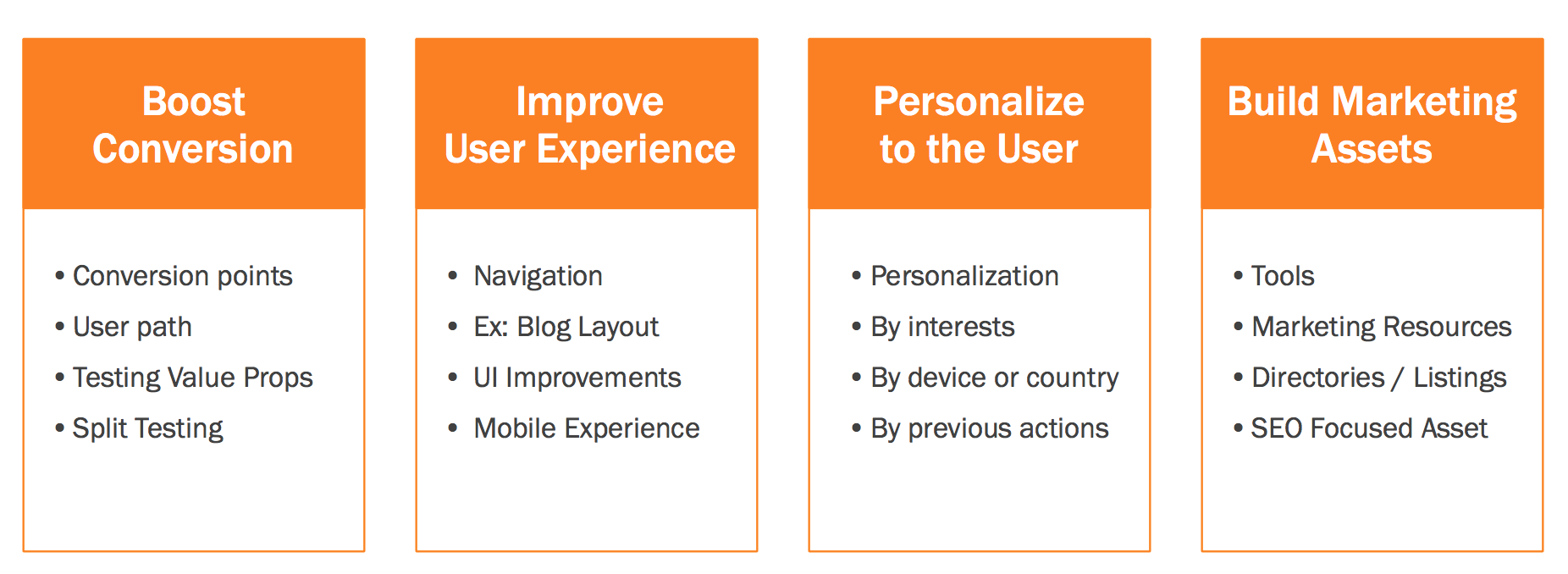When it comes to building an effective online presence, growth driven design offers a strategic and iterative approach that aligns with real user data and business objectives.
If you’re searching for methods to create a web design that is both high-performing and constantly improving, this article will guide you through the full growth driven design methodology and framework, explaining how it differs from the traditional method of static designs and its advantages for your website.
Key Takeaways
-
Growth-Driven Design (GDD) is a dynamic and iterative approach to website development, emphasizing continuous improvement through user feedback, conversion rate optimization, and leveraging data-driven insights to align with user needs and business goals.
-
The GDD process starts with a Launch Pad website, focusing on speed and ‘must-have’ features to quickly gather real user data, facilitating ongoing optimization and ensuring quick market entry with early lead and revenue generation.
-
Continuous enhancements in GDD are prioritized based on user feedback and data, employing sprint cycles for high-impact tasks, ensuring websites evolve in line with user behavior and performance data, ultimately enhancing user experience and aligning with marketing and sales insights.
Exploring the Essence of Growth-Driven Design

Growth-Driven Design (GDD) revolutionizes how we handle website design and development. Instead of viewing a website as a static entity, GDD treats it as a living, evolving entity that grows and adapts based on real data and user feedback. By implementing the growth driven design methodology, the result is a high-performing website that continuously improves and evolves to meet the needs and preferences of its users.
The core of GDD is a cyclical process, incorporating conversion rate optimization (CRO) and user-focused enhancements throughout every stage, from attracting users to converting leads and satisfying customers. By leveraging data-driven insights, GDD ensures that decisions are not made in isolation but are informed by user behavior and performance metrics, guiding the evolution of the entire website itself.
The Philosophy Behind GDD
GDD’s philosophy is deeply rooted in lean and Agile methodologies. It adopts the SCRUM agile process as its foundation, with lean and agile principles resulting in an effective and flexible web design methodology that can adapt to ever-changing user preferences, technological advancements, and market dynamics. This approach contrasts with traditional design methods, which are often static and fail to adapt to these changes.
A fundamental principle of GDD’s philosophy involves employing Agile project management systems. These systems empower teams, facilitate action, and underscore the concept of continuous, growth driven design and continuous improvement throughout. It’s this agile nature that allows GDD to respond quickly and effectively to changes, ensuring that your website is always aligned with your business goals and user needs.
Key Components of GDD
Several fundamental components synergize to propel GDD’s success. One of these global elements is strategy driven design development, which begins with an empathetic and deep understanding of the audience’s goals and challenges, and aligns the website design with measurable business goals.
Another key component is user research. GDD involves quantitative user research:
-
Creating user personas for a comprehensive understanding of audience demographics and behaviors
-
Asking targeted questions
-
Continually refining the website based on user feedback
This process is driven by data-driven methodologies, which underpin design decisions and allow for quick adaptation to shifts in user behavior and market trends.
Finally, GDD integrates Design Thinking to empathize with users and bases its iterative process on feedback, requiring various research methods and tools for implementation.
The Launch Pad: A Starting Point for Innovation

Having delved into the core of GDD, we now shift our focus to one of its groundbreaking concepts: the initial build and launch process sooner a first Launchpad site, Pad website. The initial kickoff meeting a first Launchpad site, Pad or launch pad website is the initial version of an entire website launched through the GDD process, poised for ongoing optimization and improvement. This build and launch process ensures a strong foundation for future enhancements.
The strategy behind content creation for the initial Launch Pad website is to prioritize speed and focus on impactful solutions, ultimately leading to a successful launch pad website itself. This involves using an 80/20 rule to deliver value quickly while setting the stage for further development. By focusing on essential ‘must-have’ features that represent the core of the business, the initial Launch Pad website and strategy lays a fruitful groundwork for future business growth and improvement.
The aim is to start gathering real user data as quickly as possible, start collecting data which will shape the path for subsequent design iterations and learning from actual audience interactions.
From Concept to Launch
Developing a Launchpad and website strategy is a pivotal step in the GDD process. It begins with establishing ‘must-have’ features critical for visitors to understand the business and its value proposition. These features are prioritized based on a backlog of ideas, ensuring that impactful features are developed first. This process is aided by the development of target buyer personas that represent the ideal audience.
One of the key aspects of the GDD process is client collaboration. By involving clients in the development stages, new ideas can be incorporated and clients can feel part of the project. The initial Launch Pad phase employs several methods of redesign, including:
-
Refresh
-
Kick-start
-
80/20
-
Launch and expand
These methods cater to different organizational goals and timelines. This results in a functional initial site that surpasses the existing one and is set for further optimization based on real user data.
Gathering Initial User Feedback
Following the launch of the Launchpad website, the subsequent essential step in the strategy stage of the GDD process is the collection of initial user feedback. This feedback is crucial as it helps to understand user navigation preferences and objectives, guiding informed decision-making in the strategy stage of the GDD decision making process.
A variety of methods can be used to gather this feedback. Some examples include:
-
Segmented email drip campaigns with surveys and direct feedback options integrated into the website
-
Community forums for early adopters to provide qualitative feedback through open discussions
-
Key metrics such as Site Bounce Rate, the Google Analytics Users Flow report, and tracking Landing Page and Call to Action Conversions to gain insights into user behavior and the effectiveness of design elements.
Continuous Improvement

Continuous enhancement is the essence of GDD. Unlike the traditional ‘launch it & leave it’ approach, GDD views a website as a dynamic entity that evolves based on user behavior and performance data. This means that after the initial launch, the website isn’t left to stagnate. Instead, it undergoes constant enhancements that increase its effectiveness and alignment with user needs and business goals.
To facilitate this process, GDD employs sprint cycles. These are short, focused periods for implementing high-impact tasks. Over time, these small improvements accumulate and enhance engagement and conversion rates peak performing website, reflecting a culture of continuous improvement through experimentation gather feedback and adaptation. And importantly, these revisions are aligned with marketing strategies and focused on improving the overall user experience, ensuring that the website remains relevant and user-friendly over time.
Prioritizing Website Enhancements
During the next continuous improvement phase stage and enhancement phase, assigning priority to website improvements is of paramount importance. The website optimization roadmap in GDD defines the long-term vision for the next continuous improvement stage phase stage the website, with strategies to establish, optimize, and expand website capabilities.
Prioritization is a key difference achieved by categorizing items based on their potential impact when users interact and the effort required, with a focus on high-impact items first. This process is informed by real data and user feedback, leading to evidence-based decisions that enhance the user experience.
The ongoing nature of GDD allows businesses to continuously address both user behaviour and problems, resulting in a website that evolves based on user behaviour and performance data.
Measuring Success
Evaluating success in GDD goes beyond merely examining conventional website performance metrics. Instead, it’s about tracking key performance indicators like Time Spent on Site and Average Page Views per Session, which are critical for measuring user engagement and satisfaction.
Businesses should also define specific performance metrics such as lead conversion rates to quantify the impact of incremental changes during the GDD process. Regularly collected data is crucial for making informed decisions on website improvements, and is part of the cycle of continuous analysis in GDD. By doing so, they can effectively drive business growth.
Post-launch, a focus on collecting data that guides future improvements is fundamental in driving new visitors and optimizing the site for technical SEO and conversion goals. Utilizing real data to guide ongoing enhancements ensures that a website is always progressing towards better messaging, more effective calls to action, user value, and overall conversion rate growth.
Integrating Marketing and Sales Insights
GDD extends beyond website optimization, it also encompasses the integration of marketing and sales objectives into website goals. GDD empowers websites to serve as continuously evolving sales entities, informed by the latest product insights, user profiles, and sales tactics.
The GDD sprint cycle promotes interdepartmental knowledge transfer, particularly sharing insights among marketing, sales, and service teams to refine the customer journey experience and enhance departmental alignment. Data gathered from marketing and sales interactions is crucial to informing the GDD process, enabling deliberate design decisions that boost the website’s growth and performance.
As a result, adopting GDD can lead to a more substantial return on investment compared to traditional web design methodologies.
Aligning Goals Across Teams
A unified vision, strategy, and customer-centric approach between sales and the marketing team are critical for enhancing customer experience, increasing revenue, and improving customer retention. Maintaining a continuous feedback loop between sales and marketing teams is essential for sharing insights, feedback, and data to inform global strategy development.
This involves creating detailed buyer personas, which is a fundamental step in understanding the needs of your ideal customers and clients and ensuring that the website is designed to solve their problems effectively.
Aligning the website’s goals with the broader company objectives and brand identity during the website strategy and phase is vital for driving business growth.
Leveraging Data for Global Strategy
Leveraging data for global strategy is a major advantage of GDD. Using technology tools such as CRM systems and marketing automation platforms can facilitate sales and marketing alignment, providing data-driven insights to help both marketing and sales teams work more efficiently and effectively.
Companies using GDD can respond faster to market demands due to the continuous nature of the design cycle, which allows for timely updates and feature releases. Additionally, personalization and gamification strategies in GDD have shown to significantly impact user engagement by making experiences more relevant and enjoyable.
The Advantages of Adopting GDD

The adoption of GDD brings myriad benefits, including:
-
Eliminating the need for a major upfront investment, leading to greater cost-effectiveness as costs are spread out over time with continuous enhancements
-
Allowing businesses to launch their websites faster and at a lower startup cost
-
Actively working towards business goals on a continuous basis
The benefits of GDD include:
-
50% faster and 50% cheaper alternative to traditional web design methods
-
14% higher visitor growth in just 3 months
-
Ability to evolve alongside industry trends and user needs
-
High performing website that increases business agility
-
Ability to make data-backed optimizations based on actual user behavior
GDD offers a systematic approach that greatly enhances project agility and delivers a quicker time to value. It also ensures that the website can continuously improve and meet customer needs.
Accelerated Launch Timelines
One of the most significant benefits of GDD is its capacity to expedite website launches. This allows businesses to go live faster and with lower initial costs compared to traditional website redesign and web design methods.
Unlike traditional, website development and traditional website redesign, methods that often face delays due to attempting to include every feature in the initial launch, GDD focuses on prioritizing necessary elements, which reduces time to market.
By launching traditional websites quicker, businesses can start generating leads and revenue sooner, and start collecting user data and feedback early in the process. The average time to launch a new website made through GDD is approximately 60 days, significantly less than the 108 days often required for traditional, website development projects.
Enhanced User Experience
An improved user experience is another considerable benefit of GDD. By using collected website data to guide ongoing and effective website and optimization strategies, businesses can better understand user behavior and preferences. The result is:
Implementing user-centric design principles, such as creating intuitive navigation, clear calls-to-action, and engaging content, optimizes the user journey and guides site visitors towards desired actions. Additionally, personalization of the user experience enhances satisfaction and increases the likelihood of conversions and repeat visits, positively impacting website performance metrics.
Transitioning from Traditional to Growth-Driven Design
Moving from conventional web design methods to GDD necessitates a change in mindset and strategy, which includes a smarter approach to traditional website redesign itself. Companies should embrace a mindset where the new website at launch is viewed as the starting point rather than the final goal, marking the launch pad and beginning of ongoing optimization.
The transition to GDD also involves changing work dynamics within organizations. Decisions should be prioritized based on user behavior and data analysis over personal opinions or traditional practices. Moreover, businesses moving to GDD must be ready to regularly collect and scrutinize real user data to inform and direct the continuous improvement stage website enhancements.
Assessing Your Current Web Presence
Prior to shifting to GDD, companies should evaluate their existing web presence. This involves understanding the specific business outcomes that stakeholders aim to achieve through their interaction with the organization and its online presence.
A thorough audit of the existing website should be conducted, which includes a comprehensive competitive analysis to benchmark where the new site stands relative to competitors in the same field.
Additionally, identifying the ideal user journey that a stakeholder would take on the new website is critical. This involves creating a detailed map that encompasses all potential steps and interactions they could have online with the organization.
Planning Your Growth-Driven Journey
Strategizing the shift to GDD is a crucial step. This involves establishing clear organizational objectives for the website's performance itself. A successful website-specific strategy should include an analysis of:
Creating a wish list of features and improvements can help prioritize mission-critical aspects peak performance website and plan for the incremental development of other features over time.
Additionally, businesses should consider expanding their website content and value beyond sales by including educational resources and customer support services. GDD’s acceleration methods facilitate the transition of projects to this model, allowing for immediate data collection and continuous improvement post-launch.
Summary
In this journey through the world of Growth-Driven Design methodology, we’ve explored how this revolutionary approach to growth driven by design is transforming the landscape of web design. From the philosophical underpinnings of GDD to the practical steps involved in transitioning from traditional web design methods, it’s clear that GDD offers a more dynamic, efficient, and effective way to design, launch, and maintain websites.
As we’ve seen, the benefits of adopting GDD are numerous, from faster website launches and greater cost-effectiveness to enhanced user experience and higher visitor growth.
By focusing on continual learning from user feedback and data, GDD ensures that a successful website that is always progressing towards better messaging, more effective calls to action, and overall conversion rate growth. As we move further into the digital era, embracing GDD isn’t just a smart choice—it’s a necessary one for businesses looking to thrive in today’s fast-paced digital landscape.
Frequently Asked Questions
What is a growth-driven design?
Growth-Driven Design is an efficient and productive approach to website design and development, involving a driven design, continuous growth driven learning and continuous growth driven improvement to create high-performing websites.
What are the three stages of growth-driven design?
The three stages of growth-driven design are the strategy stage, launch pad, and the continuous, growth driven design and continuous improvement, phase. This approach allows for a quick launch and adaptability to evolving community needs.
Why is it important to implement the transfer step at the end of each sprint cycle?
Implementing the "transfer" step at the end of each sprint cycle is important because it helps everyone in the company stay focused on serving the same end user, rather than getting caught up in their own department's bubble.
How is GDD different from traditional web design methods?
GDD differs from traditional web design methods by treating a website as a living, evolving entity, whereas traditional methods view it as a static entity. This helps in adapting the website based on real data and user feedback.
What is a Launch Pad website in GDD?
A Launch Pad website in GDD a launch pad website is the primary version of a site launched through the GDD process, emphasizing essential 'must-have' features and positioning effective new website for continuous optimization and enhancement.

